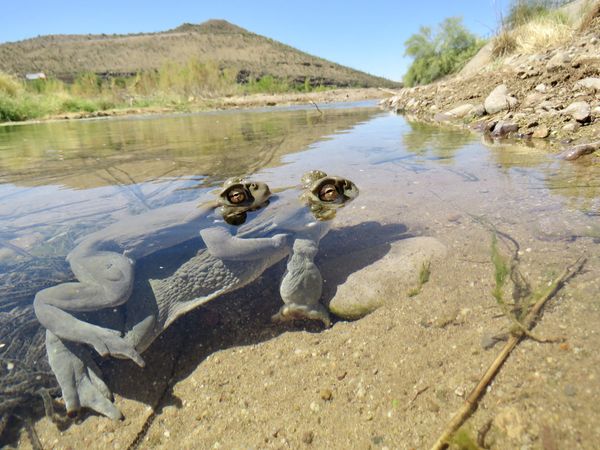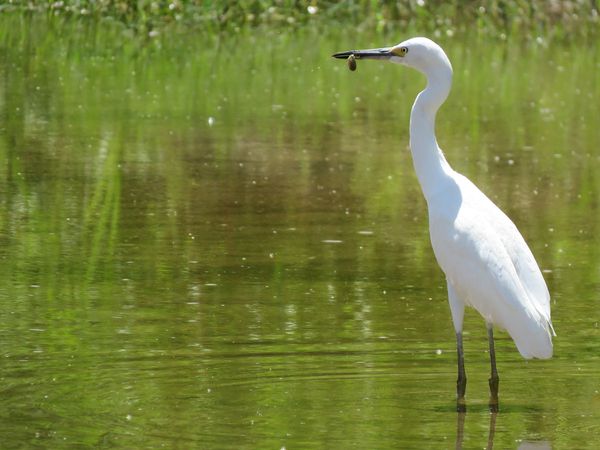
Arizona's Santa Cruz River is currently imperiled. Stretching for 180 miles through major cities like Tucson and into the Sonoran desert, the Santa Cruz River is in danger of drying up because of human factors like climate change and irresponsible wastewater disposal. Yet even though sewage is not the stuff of romance and legend, the same gross stuff that has helped imperil the Santa Cruz River may help save it.
Wastewater is filled with human feces, garbage and other gross gunk that carries dangerous disease, and is piped away from our civilization for that reason. Yet according to a recent study in the journal Restoration Ecology, effluent — or sewage that has been dumped into a body of water, like a river or ocean — can be used to help the environment, at least if used strategically.
The scientists decided to address the loss of freshwater biodiversity in urban areas, where rivers continue to be dewatered, channeled and dried up due to climate change. In Arizona's Santa Cruz River, where effluent has restored the flow more than 100 years after the river dried up, the researchers discovered over a two year period that large invertebrates flourished after the initial flow was restored and channels were dredged. Importantly, these population growths were sustained up to two years later.
As the conservation science manager in Pima County at the Conservation Lands and Resources department, Ian Murray regularly interacts with the Santa Cruz.
"It's very useful and I think important to see that even with sort of these big scale management activities, scraping away sediment from the river, drying the river, putting water back, that at least as the invertebrates go, the recolonization process was able to see diversity levels very, very similar" to what they had been prior to human meddling, Murray told Salon.

In one sense, the experiment arose from Bogan turning a potential setback into an opportunity. Bogan recalled that the Pima County Regional Flood Control District eventually decided they would need to stop the newly restored flow in the Santa Cruz River so that riverbed dredging could resume and protect the nearby city of Tucson.
"My initial response was being really sad that we'd lose this brand new, vibrant ecosystem," Bogan said. "But then my 'science-brain' kicked in and I thought, 'Wait a minute, this is a perfect chance to see if species will return so quickly again like they did the first time – who gets a chance to experiment with an entire river?' Thankfully, the species did return just as fast the second time, demonstrating how resilient nature can be if you just give it a chance. And in the second year, after the riverbed dredging, the City of Tucson implemented some great changes in how they release water into the river, including minimizing changes in river flow from day to day, and that resulted in even more species coming back to the river."
The return has included insects like water bugs that feed birds and other wildlife.
"In fact, the number of bird species in the restoration site has gone up dramatically because they love eating all the aquatic insects emerging from the river," Bogan said.
The research has implications far beyond bringing small natural wonders back to a busy metropolis. Cities all over America are drying up because of poor resource management and global heating, making it all the more imperative for city officials to seek ways of watering our communities. If anything, this study just underscores how our ongoing mass extinction crisis is a choice — and one that we can help reverse with some low-effort strategies.
"We can undo some of the damage that we've done to rivers and their inhabitants across the western USA," Bogan said. "For more than a century, the growth of cities and towns has resulted in rivers running dry and aquatic and riparian species going extinct as their habitat disappears. This is a rare 'good news' story in ecology and wildlife, where human development is actually helping to restore an ecosystem — in this case, specifically by using our city's treated wastewater to do so."

"Even 15 years ago, the wastewater treatment process in Tucson was not good enough to produce high quality, clean effluent that could help restore riverine ecosystems," Bogan said. "But thankfully, Pima County chose to invest in upgrading the treatment facilities, and as a result we have very clean effluent to use for ecosystem benefit. I think it's important for people to know that each aspect of decision making in their local city and county governments can have huge impacts on the wildlife and ecosystems of their city — and in return, the livability of their city.
Now the Santa Cruz River is home to dragonflies and mayflies, Gila topminnows and Longfin dace. When Bogan reflects back on what he has accomplished in his little corner of Arizona, he emphasizes the fact that it does not take much water to make these seeming miracles come to life.
"I really hope people take away from our research how little water it takes to have a huge positive impact on wildlife," Bogan said. "In the case of the Santa Cruz River Heritage Project, the effluent being used to restore flow in the river is far less than 1% of the treated wastewater that our city generates each day. Just a tiny fraction of our treated wastewater is having a massive benefit, supporting hundreds of species and a wonderful urban oasis of green trees and cool water. I hope that other cities across the western USA can learn from Tucson and implement similar flow restoration programs with their high-quality treated wastewater as well."
Murray also said the research is "highly applicable" to other rivers.
"I think it's really important to educate the citizens, the stakeholders, the people who live where can play near these systems to really allow them to sort of understand and appreciate what these systems are, what benefit they have to them," Murray said. "And really you can only sort of promote stewardship and conservation with people if they understand what's going on and can see the benefit to them."







